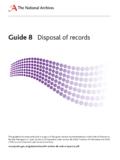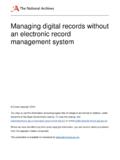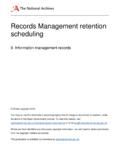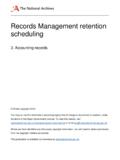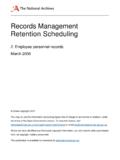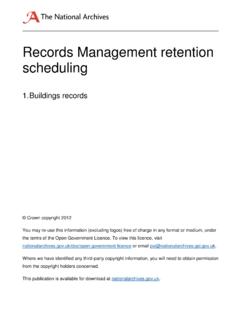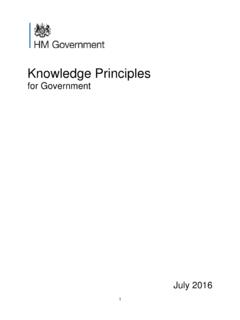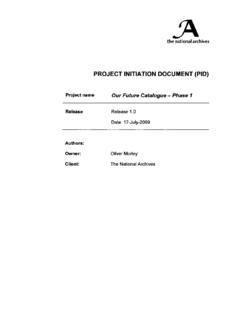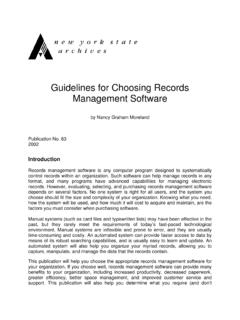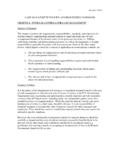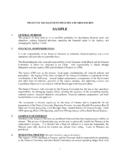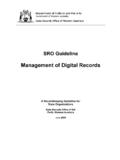Transcription of Guide 3 Records management policy (2010)
1 Guide 3 Records management policy This guidance has been produced in support of the good practice recommendations in the Code of Practice on Records management issued by the Lord Chancellor under section 46 of the Freedom of Information Act 2000. A PDF version of the full code can be found here: Who should read this Guide This Guide is written for people who have no background in Records and information management but find themselves responsible for it within their organisation, or have some other reason for acquiring a basic understanding of the subject.
2 What this Guide is about This Guide is one of a series of guides produced to support the good practice recommendations in the Code of Practice on Records management issued by the Lord Chancellor under section 46 of the Freedom of Information Act 2000 (from now on this Code of Practice will be referred to as the Code'). This Guide covers the second good practice recommendation in the Code: Authorities should have in place a Records management policy , either as a separate policy or as part of a wider information or knowledge management policy .
3 '. It explains why a Records management policy statement is important and expands on the guidance at section 7. of the Code about its contents, and how it should be developed and issued. The Guide is arranged in the following sections: 1 Purpose and scope of the Records management policy 2 Contents of the Records management policy 3 How to write a Records management policy 4 Issuing and implementing the Records management policy 5 Reviewing the Records management policy At the end there are references to some further guidance and a list of other guides in this series.
4 Note that these guides do not apply to the management of archives, the small proportion of Records selected for permanent preservation and transferred to an archives service once they were no longer needed by the organisation for current business or legal reasons. Crown copyright 2010 . The text in this document (excluding the Royal Arms and departmental or agency logos) may be reproduced free of charge in any format or medium providing that it is reproduced accurately and not used in a misleading context. The material must be acknowledged as Crown copyright and the title of the document specified.
5 Enquiries about any other use of this material, please write to The National Archives, Information policy Team, Kew, Richmond, Surrey TW9 4DU or email Last updated 31 August 2010 2. 1 Purpose and scope of the Records management policy A Records management policy is a cornerstone of effective management of Records in an organisation. It: demonstrates to employees and stakeholders that managing Records is important to the organisation provides a statement of intentions that underpins a Records management programme serves as a mandate for the activities of the Records manager provides a framework for supporting documents such as procedures, business rules, disposal schedules etc.
6 For all of these reasons the Code recommends that all organisations should have a Records management policy in place. However, the Code recognises that some organisations may prefer to include Records within a wider information or knowledge management policy and leaves it open to them to choose this option. The important thing is that whatever the policy is called, it should be clear to those reading it that it covers Records . For simplicity this Guide will continue to refer to the policy as a Records management policy . The Records management function should be comprehensive in terms of: format it should cover all Records , whatever the technology used to create and store them and should include business systems1 as well as traditional correspondence files and email lifetime it should cover Records throughout their life, from planning and creation through to disposal location it should include Records wherever they are and should also cover Records managed on behalf of the authority by an external body such as a contractor.
7 But it need not be a long and detailed document. Indeed, depending on your organisation's general approach to policy documents, it may be more successful if it is short and strategic. top tip eep the policy short leave details of how Records are managed and K. instructions to staff to supporting documents unless your organisation's policies habitually contain this level of detail. 1 Examples of business systems are a finance system which Records all of the organisation's financial transactions and holds the information required for managing budgets and audit, and a call centre customer management system Last updated 31 August 2010 3.
8 2 Contents of the Records management policy The exact contents of the policy will depend upon the overall policy framework of the organisation. Below is a description of the things that the Code recommends should be included as a minimum: Overall commitment Role of Records management References to related policies Responsibilities References to supporting documents Monitoring of compliance Overall commitment Inclusion of a commitment to keep Records of the organisation's activities informs all staff of the importance attached to managing Records .
9 The policy should define the scope of this commitment in terms of activities and Records covered see the references to comprehensiveness in section 1 and leave staff in no doubt that their work and their Records of their work fall within its scope. Ideally it will include a commitment to conform to the Code. Role of Records management There should be an explanation of the relationship of Records management to the overall business strategy, by reiterating that information is an asset considered essential to the work of the organisation. References to related policies A Records management policy does not exist in a vacuum but is part of the organisation's overall policy framework.
10 The policy should outline clearly how it relates to other organisational policies (see also section 3, step 6 below). There may also be technical policies governing the selection of new types of technologies that process electronic Records , and preservation or maintenance policies addressing the ongoing viability of such Records for as long as they continue to be required. There may even be individual Records management policies agreed with particular business units which would count as subsidiary policies. Responsibilities There should be a description of the responsibilities of managers, staff (permanent and temporary), contractors and volunteers with respect to Records management .
